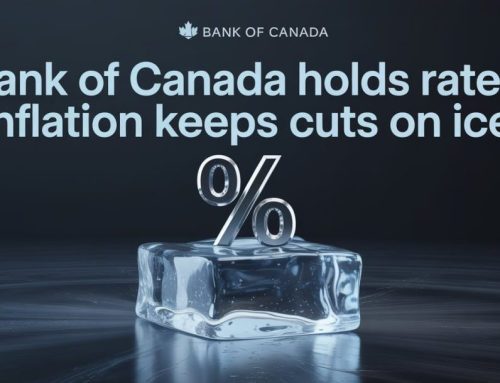The Bank of Canada announced this morning that they will be increasing their overnight rate by another 0.75%. This means that prime rate will rise from 4.70% to 5.45%, which is the highest it has been since 2008.
This means that the Bank of Canada has now increased their rate by 3.00% in just six months.
But will they stop here, or is this madness expected to continue?
Scotiabank, RBC and BMO all believe that we’ll see one more increase of 0.25% before the end of the year. The other half of the big six, CIBC, TD and National Bank, all believe that this will be the last of the rate increases in this trend. These forecasts were made prior to the BOC announcement, which stated that further increases will be required. Let’s hope the original predictions from the big six are correct and that the most we’ll see is another 0.25%. Time will tell.
It’s nice to know that the big six banks are not forecasting any increases in 2023. Hopefully it stays that way, but anything can happen. It all comes down to how quickly inflation is brought under control and the Bank of Canada will continue to do whatever they need to do to make that happen.
The BOC’s Battle Against Inflation
The Bank of Canada has been on a mission to bring inflation under control. Eventually they will get there, but it will take some time.
Here’s an excerpt from today’s announcement:
“CPI inflation eased in July to 7.6% from 8.1% because of a drop in gasoline prices. However, inflation excluding gasoline increased and date indicate a further broadening of price pressures, particularly in services.”
They also went on to say that “short term inflation expectations remain high”.
The BOC is aware that their recent rate hikes are not going to have an immediate effect on inflation, just as they are aware that they will not have an immediate effect on the economy. It can take anywhere from 12 to 24 months for the full economic effects of the rate increases to become known.
When Can We Expect Rates To Drop?
The sooner inflation is under control, the sooner we can expect the rate to drop. Until then, rates will remain high.
One of the key reasons why inflation has become a problem is due to pandemic related supply issues. Then war in Ukraine exacerbated the issue, which is what threw off previous rate predictions early this year.
The Bank of Canada rate increases will not help the supply shortages, but their intention is to bring demand down in line with the current supply. This will come at the expense of the economy.
The supply will eventually return, and the Bank of Canada will then need to shift their focus to stimulating the economy by lowering their rate. This is expected to happen at some point in 2024.
There is now some speculation that we could see a cut at the end of 2023.
This is all speculation based on the current environment. The next inflation report will be in October, so let’s hope that we start to see some progress. If inflation doesn’t start to ease soon, then further rate increases may be required, and current predictions may change.
The Effect Of The Rate Increase On Your Payment
Anyone currently in a fixed rate mortgage will have the same payment until the end of their term.
For those with adjustable-rate mortgages (variable where payments change with prime rate), your payment will increase by roughly $38 for every $100,000 owed on your mortgage.
For those with true variable rate mortgages (static payment for the term), your payment will not change. However…. This latest 0.75% increase will put many over their trigger rate, which means that the payment will no longer be enough to cover the interest. The excess interest, also known as deferred interest, will get added to your mortgage balance.
If you’re in a true variable rate mortgage, then your lender should notify you if you hit the trigger rate. They likely won’t require you to take any action, but policy can differ among lenders. I discuss this in detail in my recent blog on mortgage trigger rates.
How This Increase Affects Your Preapproval
The 0.75% rate increase will also mean that the minimum qualifying rate will also be increasing. This is also known as the mortgage stress test, which means that mortgage applicants have to qualify based on a higher rate to ensure that you can still afford the payments in a rising rate environment.
The stress test rate is the higher of the benchmark rate set by OSFI, which is currently 5.25% or 2% above your contact rate (the rate your payments are based on). Given rates have increased, anyone applying for a mortgage today will need to qualify based on the latter.
For example, if the lowest 5 year fixed rate you’re eligible for is 4.49%, then you would need to qualify based on payments calculated at 6.49%.
Anyone who currently has a preapproval with a fixed rate locked in is protected and nothing will change as long as they close on their new purchase within the 120 day rate hold period.
Anyone looking for a variable rate mortgage will now have to qualify as if the rate was 0.75% higher. This will reduce your maximum mortgage amount by roughly $50,000. In other words, if you previously qualified to for a mortgage of $900,000, it would now be reduced to a maximum of roughly $850,000.
This may shut some people with tight budgets out of the market entirely. If you’re looking to increase your maximum preapproved amount, then you may want to read my blog on 7 Ways To Qualify For a Larger Mortgage.
Conclusion
While the Bank of Canada has increased their rate by 3.00% since March, we should be getting pretty close to the end. Market predictions can only be based on the information available today. Circumstances can change, just as they did with the pandemic and the war on Ukraine. Time will tell and anything can happen.
You can read the full report on today’s increase from the Bank of Canada.
The next scheduled rate announcement will come on October 26th.








Your point of view caught my eye and was very interesting. Thanks. I have a question for you.
Thannk you. Would be happy to help.